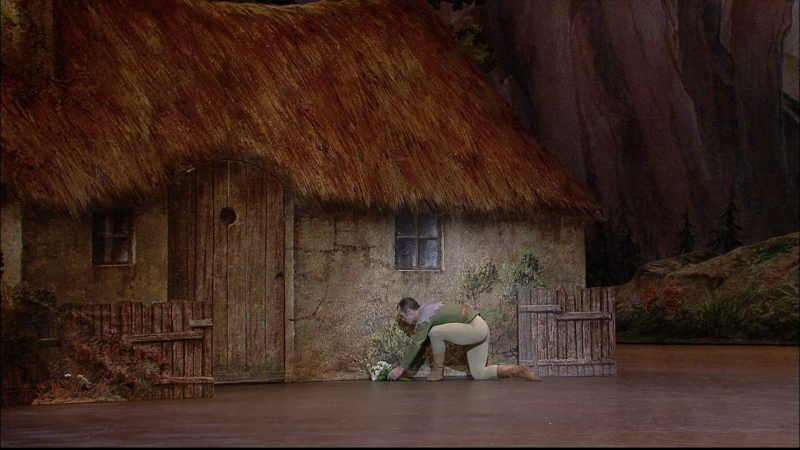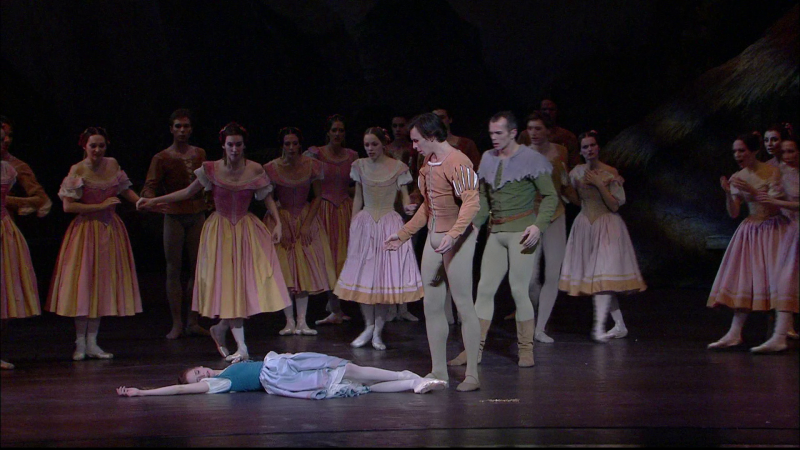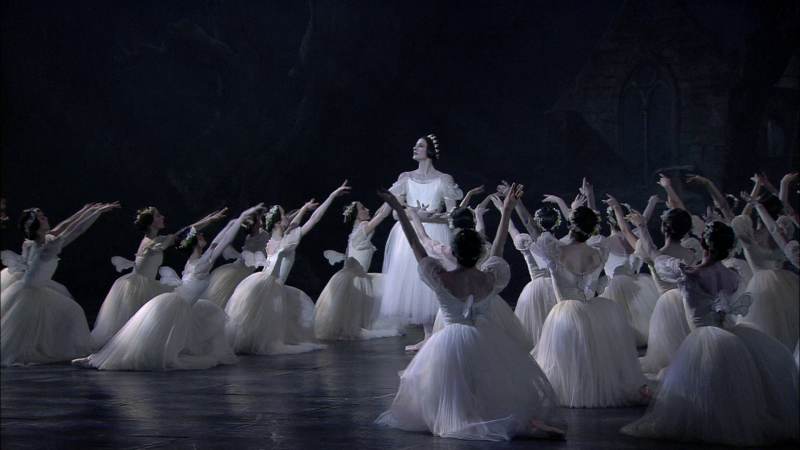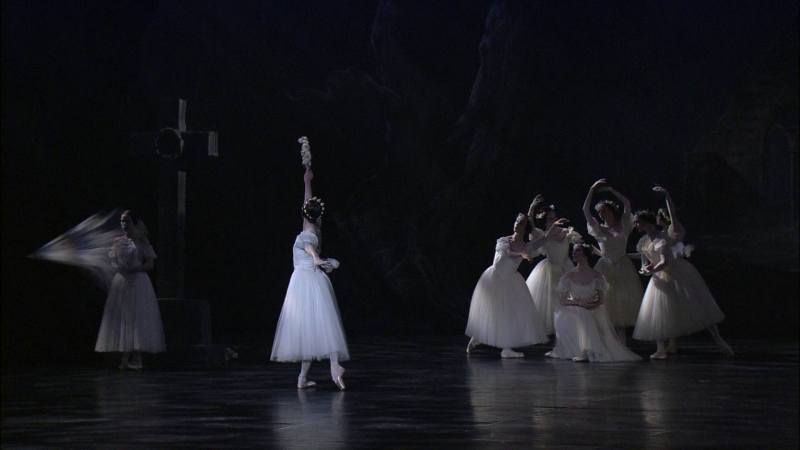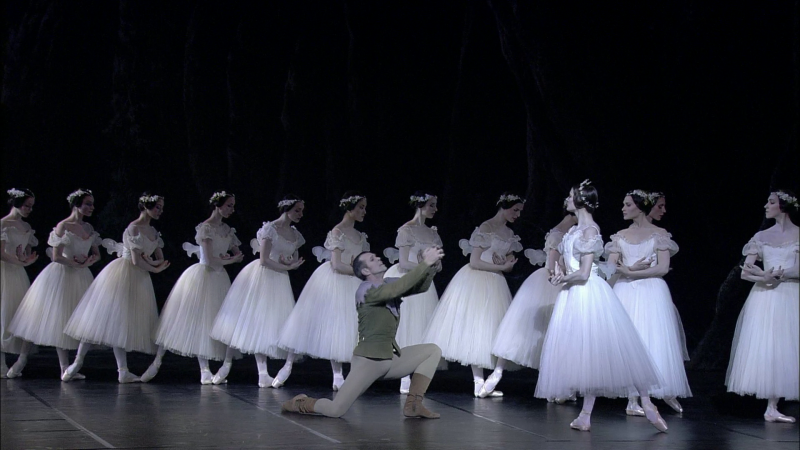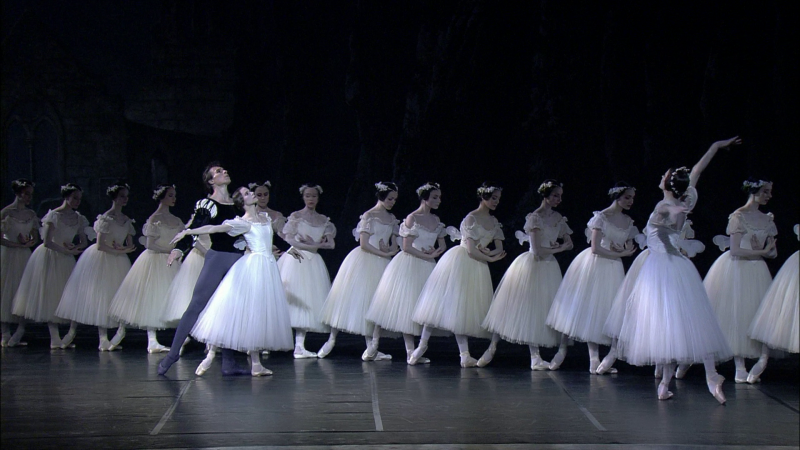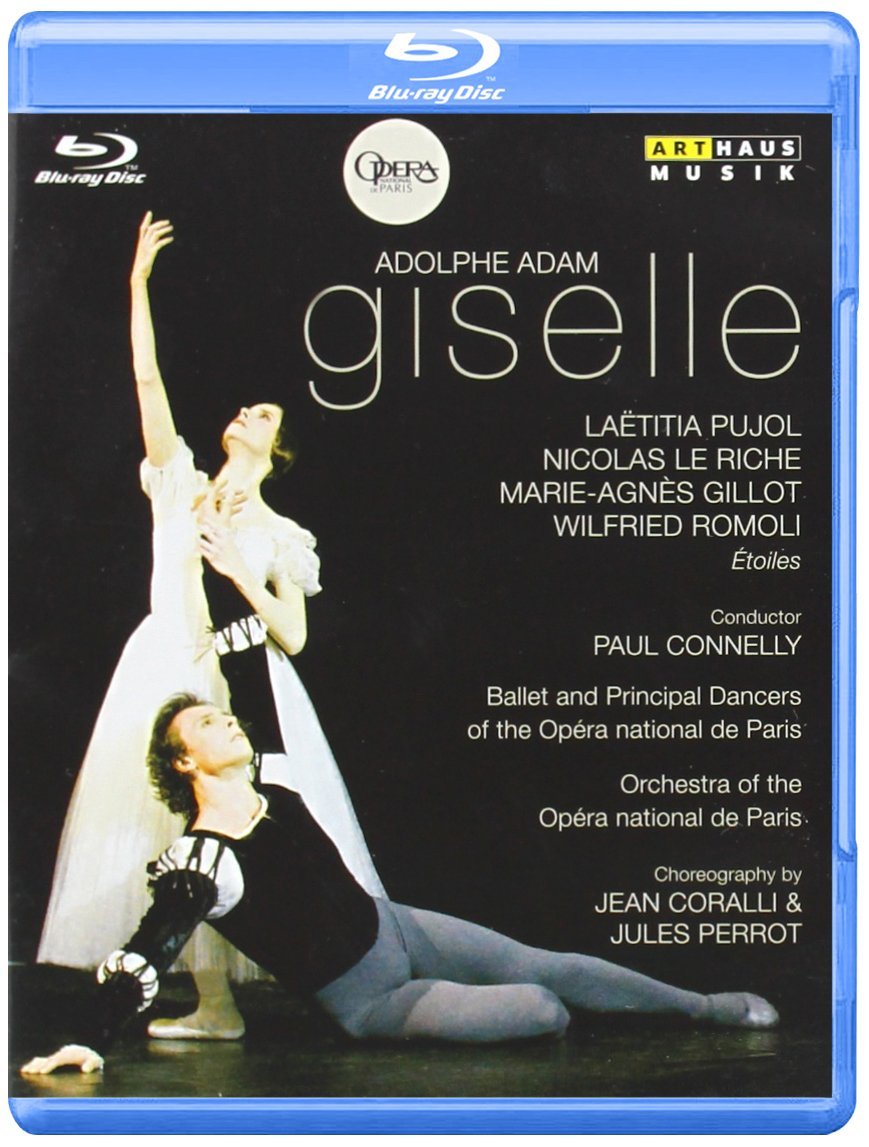
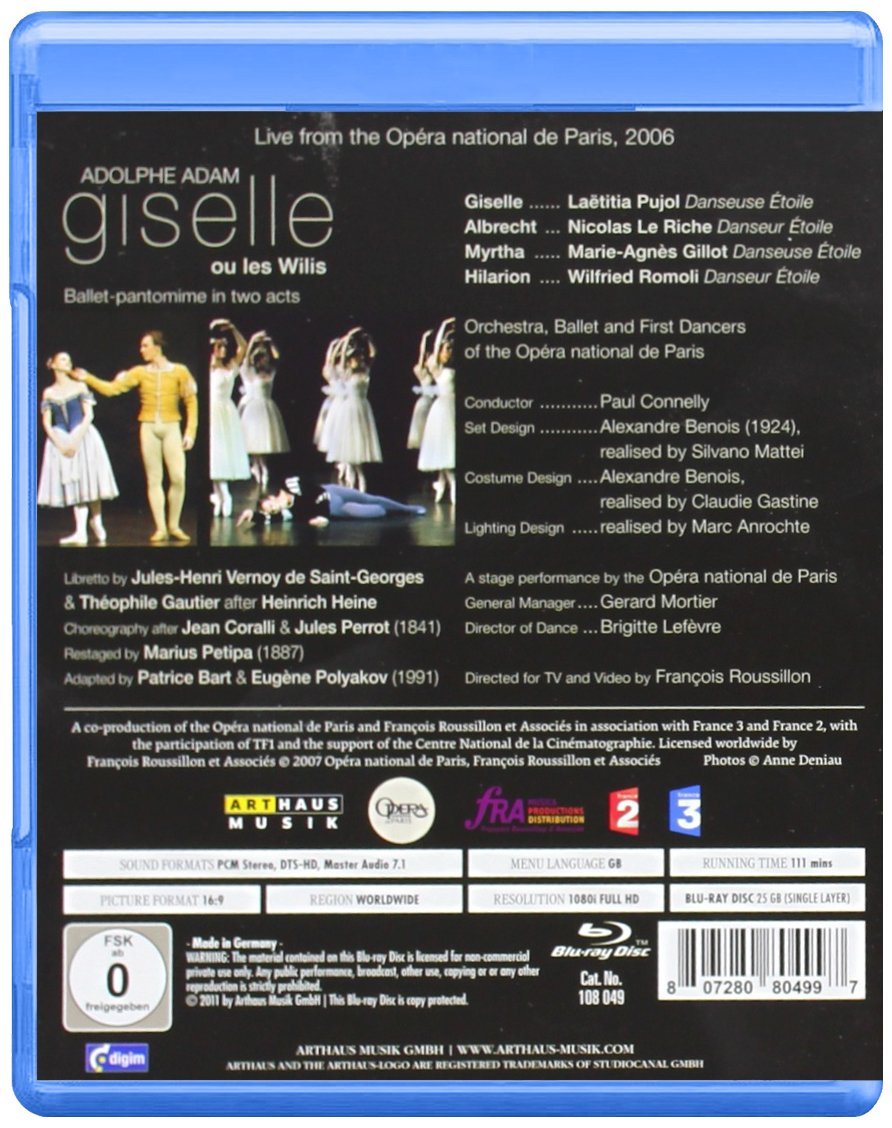
Giselle ballet. Music by Adolphe Adam to libretto by Jules-Henri Vernoy de Saint-Georges & Théophile Gautier. Choreographed by Patrice Bart and Eugène Polyakov based on Petipa tradition and performed 2006 at the Opéra National de Paris, Palais Garnier. Stars Laëtitia Pujol (Giselle), Nicolas Le Riche (Albrecht), Marie-Agnès Gillot (Myrtha), Wilfried Romoli (Hilarion), Richard Wilk (Prince of Courlande), Natacha Quernet (Princess Bathilde), Danielle Doussard (Berthe), Stéphane Elizabé (Wilfred), Myriam Ould-Braham, Emmanuel Thibault (Peasant pas de deux), as well as Emilie Cozette and Laura Hecquet (Two wilis). Paul Connelly directs the Orchestre de l'Opéra National de Paris. Sets by Alexandre Benois realized by Silvano Mattei; costumes by Benois realized by Claudie Gastine; lighting realized by Marc Anrochte. Directed for TV by François Roussillon. Released 2012, disc has 7.1 dts-HD Master Audio sound. Grade: A+
This is the exact same title that was released in 2009 by TDK. TDK phased out of HDVD and the rights to their titles were taken up by others.
With this Arthaus version, we have 3 Giselle HDVDs. From Opus Arte we have the Cojocaru/Kobborg/Nuñez version by the Royal Opera House ("ROH"). We have the Pujol/Le Riche/Gillot version from the Paris Opera Ballet ("POB") which beginning 2012 is being sold by Arthaus. Finally we have a Kultur 2010 Tsygankova/Varga/de Jongh take with the Dutch National Ballet ("DNB"). This review will present a brief shootout of the three titles.
In Act 1, we meet the tender, innocent peasant girl Giselle who is in love with the handsome Albrecht. Albrecht pretends to be a peasant youth, but he's really a nobleman who is engaged to a girl of his own class. Giselle's mother Berthe warns Giselle of the dangers of romance and tells Giselle about the Wilis, the ghosts of jilted girls who died before their weddings and who haunt the nearby forest. Hilarion, a peasant hunter who loves Giselle, is suspicious of Albrecht. When Hilarion reveals Albrecht's identity and his duplicity, Giselle goes mad and dies. Everyone is distraught, including Albrecht, who, we begin to understand, truly preferred Giselle to the noble lady with whom he has been matched.
In Act 2, Giselle has been buried in the forest. 26 Wilis and their Queen, Myrtha, prepare to receive Giselle as their latest initiate. Giselle will then help them accomplish their mission: to trap young men (whether guilty or innocent) and force them to dance until they die from exhaustion. Hilarion visits Giselle's grave and meets his doom. Albrecht also visits Giselle's grave and is captured by the Wilis. But Giselle rebels and protects her sweetheart just long enough for the dawn to arrive and disperse the Wilis. Albrecht escapes, but he must live out his life knowing that he will never see his true love again.
In Act 1, the ROH has the best mise-en-scène with updated sets, warm lighting, beautiful costumes, great acting, and coherent direction. Everybody in the cast, selected for acting ability or sex appeal as well as dancing prowess, seems 2 to 10 years younger than their French counterparts in the POB. Picture quality is excellent with vivid and skillful editing. The sound is adequate. Cojocaru is cute and charming. Her mad scene is deeply pathetic. She stabs herself and then dies hard, which means that she will be buried in the forest, and not in the churchyard, where those who commit suicide are not allowed. Sandra Conley is touching as Giselle's mother, Martin Harvey as Hilarion is appealing, and Johan Kobborg as Albrecht seems worthy of sympathy, especially after we meet his fianceé played haughtily by Genesia Rosato, who appears to be 5 to 10 years older than he.
In contrast, the approach of the POB to Act 1 is cooler and more formal. It features larger dancing formations—executed with impressive skill—that need full-stage photography. I get the impression that the sets and costumes have been packed and unpacked a great many times. Pujol is maybe a bit too old and mature to be the Giselle the girl, but she makes up for this with her assured dancing skills. For example, there is a scene where Giselle hops repeatedly on pointe on her left foot. Cojocaru does 24 small hops which are hardly noticable among all that is going on. But Pujol makes an almost unbelievable display of this with 34 big, bold hops that take her half across the stage while she laughs and flirts with all the spectators standing around gawking. The other stars are only OK. Picture quality is a bit disappointing, but the POB has the better sound with 7.1 dts-HD Master Audio.
The Kultur video was made from the first ever production of Giselle by the DNB. For the Dutch folks to compete with the ROH and the POB in this might be a bit like Lichtenstein getting into a soccer tournament with England and Brazil. The DNB forces obviously had a lesser budget than the others and their small forces looked rather thin on the big stage. On the other hand, Varga seemed to me to be the best Albrecht in this group. Kultur is entering the market at a lower price point than Opus Arte or TDK. This means Kultur has to cut corners---picture quality is only adequate and the "5.1 Dolby" sound is feeble when compared to the TDK disc.
Act 2 is a ghost story in ballet blanc. Now the tables are turned in favor of the formal approach of the POB. Marie-Agnès Gillot is commanding as Queen of the Wilis, a task that is too much to ask of the younger and shorter Nuñez. Pujol is prettier as as ghost than she was as a girl. The cool lighting of the POB is perfect now, with a mottled blue-white pattern that allows you to see well enough while preserving a sense of mystery. The blue light washes out the pink skin hues to the point that the dancers look as well as dance like spirits. At Myrta's command, the veils of all the jilted girls instantaneously fly offstage as if by magic. The cameras in Paris are positioned in the balconies where they look down on the stage and reveal the exact location, rank and file, of each dancer at every moment throughout all their formations. This gives us rolling proof of the discipline, control, and perfection for which the Paris female corps is famous. (If their formations were any more orderly, it would start to look like a computer simulation.)
In contrast, the cameramen in London shoot Act 2 from positions level with the stage. This they do, I think, in an (only partly successful) attempt to obscure irregularities and raggedness in the ROB ballet-blanc formations. This leaves the female corp of the POB in charge. But let's don't forget about the Dutch! Igone de Jongh is gorgeous and terrifying as Myrtha. Varga bests his competition in portraying Albert's grief. And the Dutch corps worked hard on their white formations, which are better than those of the ROH and almost as impressive as the work of the POB.
So here's how I sum up the 3 Giselles. Act 1 is a the story of a girl who died. Act 2 is a ghost story. The ROH focuses on the girl and has the best Act 1. The POB focuses on the ghosts and has the best Act 2. The DNB has only a fair Act 1, but they surpass the ROH and are competitive with the POB in Act 2. The prettiest scene in all three versions belong to the DNB when the corps circles Myrtha in the smoke at the beginning of Act 2. For young children and ballet newbies, the ROH disc will probably be more fun. For all others, the POB disc must be preferred because of it's admirable white scenes and superior sound. The DNB disc would be an option if you are in Region A, have an entry-level home theater, and you are on a tight budget.
After we published the shoot-out above, the Bolshoi also released a Giselle, but it isn't competititve with the three titles discussed above.
Here are some screenshots from the POB Giselle:
Hilarion (Wilfried Romoli) is a peasant who's in love with Giselle:
But Giselle (Laëtitia Pujol) loves the peasant Loys (Nicolas Le Riche), who is really Albrecht, a nobleman in disguise:
The villagers love to dance. The POB puts many combos and as many as 32 dancers on the stage in the various Act 1 numbers:
Royals are out hunting and stop at Giselle's home for refreshment. Giselle, who makes her own clothes, admires Princess Bathilde's (Natacha Quernet) garments.
Bathilde is kind to Giselle and gives her a beautiful gold necklace. This leads to more dancing by the peasants. Here we see Myriam Ould-Braham and Emmanuel Thibault:
Giselle is so happy with the necklace that she can show to Loys (but where did he go?). Here Pujol is doing 34 consecutive hops on the left foot; I think she is really laughing here at all those other ballerinas in the world who can't do this:
The royals leave and Loys reappears. But he is challenged by Hilarion, who calls on the hunting horn for the royals to return. Now Loy is identified as Duke Albrecht. Even worse, Giselle finds out that Albrecht is engaged to marry Bathilde:
Puhol is an excellent actress who puts on an impressive mad scene:
And dies from the shock to her weak heart:
Act 2 opens with a solo dance by Myrthe, Queen of the Wilis:
The Wilis appear first in veils:
After the veils are withdrawn, the Wilis honor Myrtha with numerous formations:
Giselle arrives. Her veil also disappears so she can join the sisterhood of jilted girls:
Albrecht visits the grave of Giselle in the forest, and we see his grief and remorse:
Albrecht puts the lillies on Giselle's grave. Albrecht can't see Giselle. But in an exquisite scene, he senses that she must be present and must be the one who spilled roses before him:
Now Hilarion visits the grave also. He is captured by the Wilis and dances until he dies:
Soon the Wilis have Albrecht also! But Giselle defends him from Myrtha and begs for a reprieve:
There follows a magnificent but gentle pas de deux:
And another appeal to Myrtha for clemency:
No exceptions: Albrecht was caught and must die!
Too bad Giselle died so young. She would have made an great lawyer. Here her delaying tactics pay off for her client. Now the sun is coming up. The Wilis must return to the secret coves where they reside during the day, and Albrech will live.
OR
